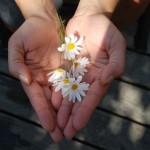Podcast: Download
Subscribe: RSS
Grief is a normal and natural process by which a person makes a healthy adjustment to any significant loss in his or her life. Any significant loss (the death of a loved one, the loss of a job, a broken marriage, deterioration of health, a shattered dream) triggers the process. Most people experience some or all of the below emotional responses when they lose anything or anyone important in their lives. But first, read Barb’s story through ignoring the emotional responses listed. Then on a second reading, reflect on the various emotional responses of the grief process.
One Person’s Grieving Process by Barb Pekich
At approximately 2:00 p.m. on November 2, 1993, my husband took his own life. That event brought me and our four children face-to-face with a death we did not understand – indeed, we did not want to understand. The pain is embodied in the words of our oldest daughter Edie:
There’s no more laughter in this house
For it has passed away.
You took the joy we once had known
on that awful November day.
The pain cuts deep inside my soul
the thoughts that never end
of what has been and what will be
and where you should be now.
I want to run away and hide
from all the tears and pain.
But there’s nowhere that you didn’t touch
that I can find today.
(Depression)
My husband’s suicide brought us pain that was and is immeasurable. Initially and for some time after Bill’s death, I questioned what I could have done differently. I also experienced some regrets about things said or unsaid during the last few days of his life.(Guilt)
I have not felt a lot of anger this past year, mostly sadness. However, when the anger has spilled out, I’ve tried to channel it in some healthy ways. Some of these ways may sound bizarre, but I’m not the least bit ashamed of them. For example, I have visited the cemetery at all hours of the day and night and have sworn at him. I have dug through the snow and ice to uncover his grave marker in the dark so that I could stomp on it. I have been known to stand in my garage at night and hurl dishes against the wall. All of these actions were very therapeutic. (Anger)
One of my significant struggles has been moving from “I can’t” (I can’t be alone; I can’t be a single parent; I can’t be a widow.) to “I don’t want” (I don’t want to be alone, a single parent, a widow.) to “I am” (I am alone; I am a single parent; I am a widow.) This whole process took about nine months. I hesitate to use the word “acceptance,” for how do we “accept” what is totally unacceptable? (Denial, Panic, Fear) Remember there are no quick fixes. Grieving is a complex emotional process. It takes time.
I have not been here for five months. Not since May 2 have I stood on the ground and looked at this tree, the site of Bill’s suicide nearly one year ago. Then and in the months after, it was desolate here. Here is where I came alone, with all but one of my children and with my closest friends. I have been here several times, but have not needed to come back since May. Shortly after Bill’s death, I remarked to a friend of mine on one of these pilgrimages with me, that I never wanted things to change here. I never wanted it to look different. It was frightening to think that someday this tree, this huge white oak might not be here. (Resists returning to normal) (Feels that she must keep the memory alive) (Facing the new situation is scary/painful.)
As I climbed out of the van today with my good friend, Andy, I was struck with how much this site has altered. Everywhere new growth stood firmly and staunchly on the once trampled ground. The grass and wildflowers flourished and are unaware of the memories of what was here a year ago. The tire tracks that had plowed a path straight into the tree on that day in November now made only the smallest indention in the ground. Eleven months ago, the earth was strewn with small pieces of his car: part of a headlight here, a piece of the windshield there. There were reminders everywhere. Now it is hard to walk through the dense growth of weeds, grass and flowers in front of, besides and behind the tree. Searching the ground, I find only a small fragment of the side mirror. Oh, there are probably more pieces if I look hard, but what were once precious items that I needed to see and touch are now just broken things that I don’t need anymore. (Resists returning to normal)
Eleven months ago on a trip here with this same friend, we found part of Bill’s glasses, a vivid reminder of the person I loved that cut like a sword into my heart yet brought a strange comfort that part of him had survived. Today in nearly the same spot, amidst the gravel on the shoulder of the road, is a tiny purple flower. Even the tree has begun to heal. After the accident there were deep gouges in the bark and new wood exposed underneath where pieces of the trunk were torn off. Now, the new wood is the same color as the old; some of the old has covered over the parts that were exposed. I used to sit on a stump beside the big tree and mourn the act that so quickly left me feeling so desperately alone. Here today, I have to search for the stump. It is surrounded by brush and growth and life just as my family has been surrounded this past year. (Gradually, hope comes through) We never return to our “old selves” again. Depending on the way we respond to loss, we are either stronger than we were before or weaker.
There is little here today to remind me of the violence and the pain that were his a year ago. Thank God. This place has changed. I have changed. My children have changed. But today that thought brings me comfort. As I stand on the spot that once held the dead, I know that there is no longer anything here for me. I have gone so many times before to get in touch with the reality of Bill’s death. But today, I wonder, “Why am I seeking the dead among the living?” (Struggles to affirm reality)
At various times these past eleven months, I have tried to let go, to hang on, to let go, to hang on-to let go of my identity as a wife and hang onto my new title of “widow.” Now I am letting go of “widow” and hanging onto me. It is a process of letting go of the events surrounding Bill’s death and remembering the joy we shared in our lives together. It is a process of letting the past be in the past and a part of who I am and who my children are, and yet embracing the promises for the future. It is a process of being able to see life and beauty and feel joy and hope once more. It is a process of moving from trusting the promise that God will be with me to acknowledging the certainty that God has been here and continues to be here. It is the process of resurrection, of moving from death to life, and sorrow to joy, from Good Friday to Easter.
For additional caregiving advice, refer to the following categories: “Death” and “Caregiving Basics.”









0 Comments